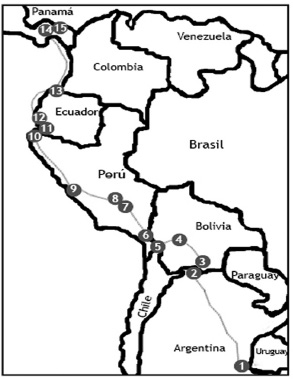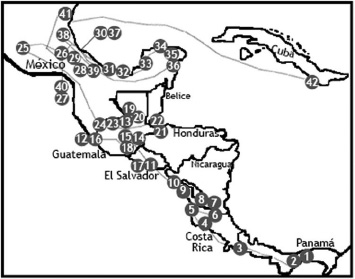Read Latin America Diaries Online
Authors: Ernesto Che Guevara
Latin America Diaries (2 page)
December 28, 1958
Che Guevara's guerrilla column initiates an audacious attack on Batista's forces in Santa Clara.
January 1, 1959
Batista flees Cuba. Santa Clara falls to the Rebel Army. Che Guevara and Camilo Cienfuegos arrive in Havana the next day.
January 8, 1959
Fidel Castro arrives in Havana.
February 9, 1959
Che Guevara is declared a Cuban citizen. He is later appointed head of the Department of Industry of the National Institute of Agrarian Reform (INRA) and president of the National Bank of Cuba and takes major responsibility for the industrialization and transformation of the Cuban economy.
March 14, 1965
Che Guevara returns to Cuba after a tour of Africa and shortly afterwards drops from public view.
April 1, 1965
Che Guevara delivers a farewell letter to Fidel Castro. He subsequently leaves Cuba on a Cuban-sponsored internationalist mission in the (former Belgian) Congo, Africa.
November 21, 1965
Che Guevara leaves the Congo, and begins writing up his account of the mission, which he describes as “a failure.”
December 1965
Fidel Castro arranges for Che Guevara to return to Cuba in secret. Che Guevara prepares for the expedition to Bolivia.
November 4, 1966
Che Guevara arrives in Bolivia in disguise.
March 23, 1967
The first guerrilla military action takes place with combatants successfully ambushing a Bolivian army column.
April 16, 1967
Che Guevara's Message to the Tricontinental is published, calling for the creation of “two, three, many Vietnams.”
May 1967
US Special Forces arrive in Bolivia to train counterinsurgency troops of the Bolivian army.
October 8, 1967
The remaining 17 guerrillas are trapped by army troops and conduct a desperate battle in El Yuro ravine. Che Guevara is seriously wounded and captured.
October 9, 1967
Che Guevara and two other captured guerrillas are murdered by Bolivian soldiers following instructions from the Bolivian government and Washington. The remains of Che Guevara and the other guerrillas are secretly buried in Bolivia.
July 1, 1968
Che Guevara's
Bolivian Diary
is published in Cuba and is distributed free of charge to the Cuban people, while it is simultaneously published in many countries.
July 1997
Che Guevara's remains are returned to Cuba and buried in a memorial in Santa Clara, along with the remains of other guerrilla fighters who died in Bolivia.
First part of Ernesto's trip (Latin America)

1. Buenos Aires
2. La Quiaca
3. Villazón
4. La Paz
5. Lake Titicaca
6. Puno
7. Cuzco
8. Machu-Picchu
9. Lima
10. Tumbes
11. BolÃvar (Port)
12. Guayaquil
13. Esmeralda
14. Balboa
15. Panamá City
Second part of Ernesto's trip (Central America)

1. Balboa (port)
2. Panamá City
3. Golfito
4. Puntarenas
5. San José
6. Liberia
7. Alajuela
8. La Cruz
9. Rivas
10. Managua
11. San Salvador
12. Guatemala City
13. Amatitlán
14. Chimaltenango
15. Tiquisate
16. Guatemala City
17. San Salvador
18. Santa Ana
19. El Progreso
20. Jalapa
21. Quiriguá Vieja
22. Puerto Barrios
23. Lake Atitlán
24. Chimantenango
25. León (Guanajuato)
26. Puebla
27. México City
28. Popocatépetl (5,450m)
29. IztaccÃhuatl (5,286m)
30. Veracruz
31. Lake Catemaco
32. Coatzacoalcos River
33. Campeche
34. Mérida
35. Uxmal
36. Chichén-Itzá
37. Veracruz
38. Córdoba
39. Orizaba
40. México City
41. Tuxpan
42. Las Coloradas (Cuba)
One of the main aims of the editorial project created by the Che Guevara Studies Center (Havana) together with Ocean Press and Ocean Sur publishing houses is to recover historical memory as an indispensable tool for new generations seeking to establish a more just and equal world, a world representing the interests of the great majority.
The book we offer here to readers belongs chronologically to the writings of the young Che, its antecedent being the journals he wrote during his first trip around Latin America, between late 1951 and August 1952 [
The Motorcycle Diaries
].
A year later, on July 7, 1953, this young man, newly graduated as a doctor, headed off again for those countries that had already captured his imagination and would determine the future course of his life. It is therefore not surprising that Ernesto gave the title
Otra vez
[once again] to this new diary.
When one starts to read this book, it becomes clear immediately why he chose this title. On page after page he draws us into his ever-growing commitment to “Our America” (as José Martà called it) and challenges us to reflect on moments and circumstances we sometimes ignore because of our daily routine.
Otra vez
is a thought-provoking book, full of clues that allow us to gain an understanding of the meaning and impact of Che's life, his thought and his actions. It shows what gradually leads
him to the path of revolution, how he makes it his own, with his characteristic questioning, hesitation, tentative answers and grappling with theory and praxis in an attempt to understand the world and his role in that world. Despite the good and bad times he describes, his great love of humanity emerges through the impressions and experiences he relates.
In these pages, he is no longer simply a spectator to events but an active participant for whom there can be no turning back. As the pages unfold, we discover a man who, from the beginning to the end of his life, demonstrated a moral stature of immense proportion. Undoubtedly, it helps us understand not only the coherence of his actions and thought from early on, but also why the icon he became has had such a broad appeal for so many people and movements in the struggle to make a better world.
This edition has been revised, corrected and expanded with original documents held at the Che Guevara Studies Center in Havana in order to create a book with which young people can identify in these uncertain times.
* * *
In this new edition, due to their historical significance, we have reproduced letters Che sent to his family and his friend Tita Infante, articles written for newspapers and journals, poems and interviews that were published in the various countries he visited in order to augment the narrative of his diary of this second journey through Latin America.
Also included are news reports from Mexican newspapers of the imprisonment of Che along with a group of key Cuban revolutionaries (among whom was Fidel Castro) who were making preparations for the liberation struggle in Cuba.
The footnotes in this edition were added by the Che Guevara Studies Center, but some of the footnotes to the letters are taken
from his father's (Ernesto Guevara Lynch) book, published as
Aquà va un soldado de América
in 1987. Unfortunately, it is impossible to explain all those people and events referred to in this diary and the letters.
Myrna Torres, who is now resident in Cuba, collaborated in the revision of the parts of this diary that cover the period in Guatemala and Mexico.
Where the diary and letters have been excerpted this is indicated by elipses in square brackets.
This diary was left incomplete because of Ernesto's momentous decision to join the Cuban revolutionaries in their struggle for the liberation and total independence of their homeland. On November 25, 1956, Ernesto (now called “Che”) left Mexico with the Cubans who were about to initiate a guerrilla struggle against the Batista dictatorship.
The voyage on the leaky cabin cruiser
Granma
and the first encounters with Batista's troops are the opening chapters of his
Reminiscences of the Cuban Revolutionary War
(Ocean Press, 2006).
Ocean Press
This book, originally published in Spanish as
Otra Vez
[Once Again], is a text of an intimate or testimonial character, indispensable to penetrate the iron-willed personality that Ernesto Guevara de la Serna forged for himself with the written word as his constant accomplice. Laced with his irony and his wit is a deep perceptiveness of his surroundings in his quest to discover the Americas, offering us a multi-dimensional panorama of his own future imbued with thought and action.
This diary was preceded by the other reconstructed chronicles of his first trip around the continent of Latin America with Alberto Granado, so full of youthful spirit, in which he describes “the joyful impulse that overcame us to be lost on the horizon of the Americas.”
This second travel diary offers to readers the prelude to the development of the fully formed revolutionary Ernesto became. It might have been reworked as a more polished manuscript as was the case with
The Motorcycle Diaries
but that did not happen for various reasons. Nevertheless, the publication of this book provides an invaluable historical legacy testifying to crucial events during Che's travels through “Our Great America.”
To assist the reader, we have added a number of letters and appendices so that the full profundity and tone of the young author's reflections and viewpoint become evident as he charts
the course of his future, a future that becomes forever linked to one of the most important events of the 20th century, the Cuban revolution.
In his eagerness to immerse himself in his surroundings, Che's passion for writing was always vitally complemented by his photography. This book, therefore, also includes previously unpublished photographs of his travels, as living testimony of the diversity of his experiences and his desire to record them as images that express his fine sensibility and passion to capture everything that excited him.
Che Guevara Studies Center
Havana

